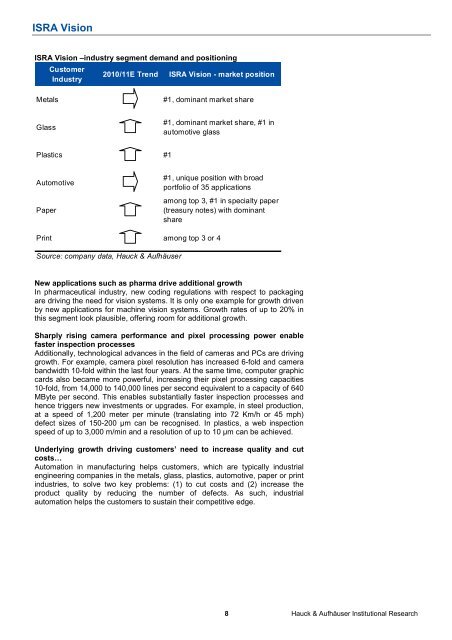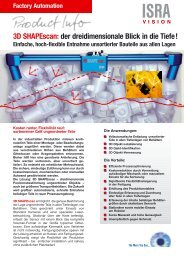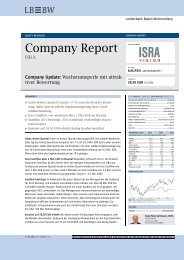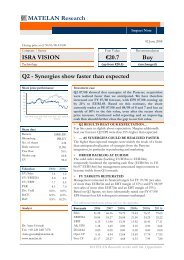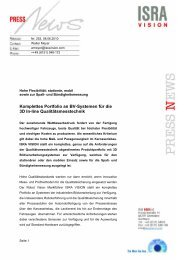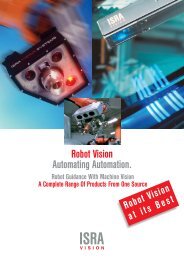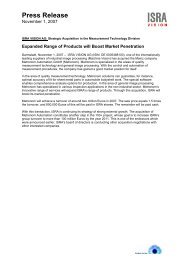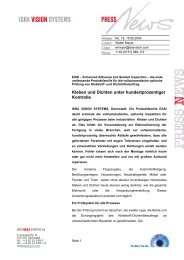Template for HA Research Notes - ISRA VISION AG
Template for HA Research Notes - ISRA VISION AG
Template for HA Research Notes - ISRA VISION AG
You also want an ePaper? Increase the reach of your titles
YUMPU automatically turns print PDFs into web optimized ePapers that Google loves.
<strong>ISRA</strong> Vision<br />
<strong>ISRA</strong> Vision –industry segment demand and positioning<br />
Customer<br />
Industry<br />
2010/11E Trend <strong>ISRA</strong> Vision - market position<br />
Metals #1, dominant market share<br />
Glass<br />
Plastics #1<br />
Automotive<br />
Paper<br />
#1, dominant market share, #1 in<br />
automotive glass<br />
#1, unique position with broad<br />
portfolio of 35 applications<br />
among top 3, #1 in specialty paper<br />
(treasury notes) with dominant<br />
share<br />
Print among top 3 or 4<br />
Source: company data, Hauck & Aufhäuser<br />
New applications such as pharma drive additional growth<br />
In pharmaceutical industry, new coding regulations with respect to packaging<br />
are driving the need <strong>for</strong> vision systems. It is only one example <strong>for</strong> growth driven<br />
by new applications <strong>for</strong> machine vision systems. Growth rates of up to 20% in<br />
this segment look plausible, offering room <strong>for</strong> additional growth.<br />
Sharply rising camera per<strong>for</strong>mance and pixel processing power enable<br />
faster inspection processes<br />
Additionally, technological advances in the field of cameras and PCs are driving<br />
growth. For example, camera pixel resolution has increased 6-fold and camera<br />
bandwidth 10-fold within the last four years. At the same time, computer graphic<br />
cards also became more powerful, increasing their pixel processing capacities<br />
10-fold, from 14,000 to 140,000 lines per second equivalent to a capacity of 640<br />
MByte per second. This enables substantially faster inspection processes and<br />
hence triggers new investments or upgrades. For example, in steel production,<br />
at a speed of 1,200 meter per minute (translating into 72 Km/h or 45 mph)<br />
defect sizes of 150-200 µm can be recognised. In plastics, a web inspection<br />
speed of up to 3,000 m/min and a resolution of up to 10 µm can be achieved.<br />
Underlying growth driving customers’ need to increase quality and cut<br />
costsM<br />
Automation in manufacturing helps customers, which are typically industrial<br />
engineering companies in the metals, glass, plastics, automotive, paper or print<br />
industries, to solve two key problems: (1) to cut costs and (2) increase the<br />
product quality by reducing the number of defects. As such, industrial<br />
automation helps the customers to sustain their competitive edge.<br />
8 Hauck & Aufhäuser Institutional <strong>Research</strong>


